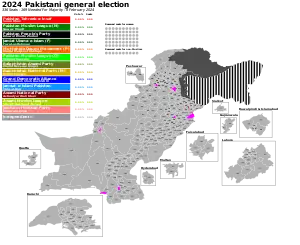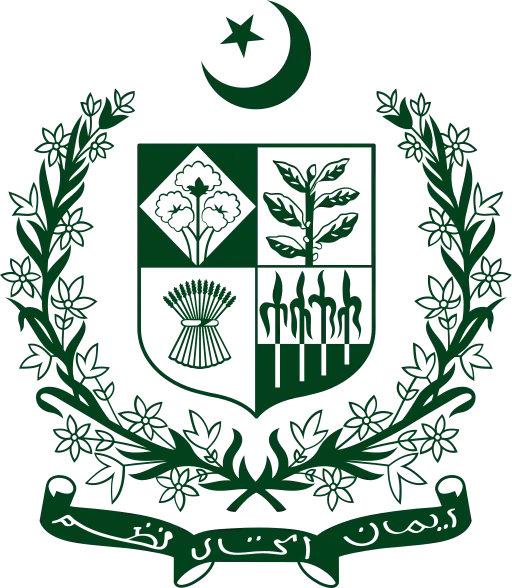| |||||||||||||||||||||
All 336 seats in the National Assembly 169 seats needed for a majority | |||||||||||||||||||||
|---|---|---|---|---|---|---|---|---|---|---|---|---|---|---|---|---|---|---|---|---|---|
| Opinion polls | |||||||||||||||||||||
| |||||||||||||||||||||
 Map of Pakistan with National Assembly constituencies | |||||||||||||||||||||
| |||||||||||||||||||||
 |
|---|
|
|
General elections are scheduled to be held in Pakistan less than 90 days after the dissolution of the National Assembly, which was prematurely dissolved on 10 August 2023 by President Arif Alvi on the advice of the Prime Minister Shehbaz Sharif. This means that the election must be held no later than 8 November 2023.[1][2] However, on 5 August 2023, the results of the 2023 digital census were approved by the Council of Common Interests headed by Prime Minister Shehbaz Sharif. Therefore, elections will be delayed until February 2024 at the latest, as announced by the Election Commission of Pakistan (ECP). However, on 13 September 2023, President Alvi proposed 6 November 2023 as a date to the ECP and advised it to seek guidance from the Supreme Court for the announcement of the election date.[3][4][5][6] On 2 November 2023, the ECP and the President agreed on 8 February 2024 as the date for the general election.[7][8]
The three major parties are Pakistan Tehreek-e-Insaf (PTI) led by former Prime Minister Imran Khan, Pakistan Muslim League (N) (PML(N)) led by former Prime Minister Nawaz Sharif and Pakistan Peoples Party (PPP) led by former Foreign Minister Bilawal Bhutto Zardari.
Background
2018 elections
General elections were held in Pakistan on Wednesday 25 July 2018 after the completion of a five-year term by the outgoing government. At the national level, elections were held in 272 constituencies, each electing one member to the National Assembly. At the provincial level, elections were held in each of the four provinces to elect Members of the Provincial Assemblies (MPA).
As a result of the elections, the Pakistan Tehreek-e-Insaf (PTI) became the single largest party at the national level both in terms of both popular vote and seats. At the provincial level, the PTI remained the largest party in Khyber Pakhtunkhwa (KP); the Pakistan Peoples Party (PPP) remained the largest party in Sindh and the newly-formed Balochistan Awami Party (BAP) became the largest party in Balochistan. In Punjab, a hung parliament prevailed with Pakistan Muslim League (N) (PML-N) emerging as the largest party in terms of directly elected seats by a narrow margin. However, following the joining of many independent MPAs into the PTI, the latter became the largest party and was able to form the government.
Opinion polling prior to campaigning had initially shown leads for the Pakistan Muslim League (N) (PML-N) over the PTI. However, from an 11-point lead, the PML-N's lead began to diminish in the final weeks of the campaign, with some polls close to the election showing PTI with a marginal but increasing lead. In the final result, the PTI made a net gain with 31.82% of the vote (its highest share of the vote since its foundation), while the PML-N made a net loss with 24.35%. In the lead-up to the elections, there had been allegations by some pre-poll rigging being conducted by the judiciary, the military and the intelligence agencies to sway the election results in favour of the PTI and against the PML-N.[9][10] The opposition to the winning parliamentary party alleged large-scale vote rigging and administrative malpractices.[11][12][13] However, Reuters polling suggested PML-N's lead had narrowed in the run-up to the elections, and that the party had suffered "blow after blow" which caused setbacks to any hopes of re-election.[14] Some[15] had termed the ruling PML-N "embattled... facing a number of desertion and corruption charges". Imran Khan proceeded to form the coalition government, announcing his cabinet soon after.[16] The newly formed coalition government included members of the Muttahida Qaumi Movement and Pakistan Muslim League (Q).[17]
Regarding the voting process, the Election Commission of Pakistan (ECP) outrightly rejected reports of rigging and stated that the elections were conducted fair and free.[18][19][20] A top electoral watchdog, Free and Fair Election Network (FAFEN), also said that the 2018 general elections in Pakistan had been "more transparent in some aspects" than the previous polls.[21] In its preliminary report, the European Union Election Observation Mission said that no rigging had been observed during the election day in general, but found a "lack of equality" and criticized the process more than it had in the Pakistani election of 2013.[22][23]
Electoral system
The 336 members of the National Assembly consist of 266 general seats elected by first-past-the-post voting in single-member constituencies,[24] 60 seats reserved for women elected by proportional representation based on the number of general seats won by each party in each province, and ten seats reserved for non-Muslims elected through proportional representation based on the number of overall general seats won by each party.
The government had passed a bill that required the next general elections to be held using EVMs (electronic voting machines). This was aimed at bringing an end to the allegations of rigging that have plagued previous elections in Pakistan, but the opposition's opinion was that it would make it extremely easy for PTI to rig the elections in their favour through security loopholes.[25] In 2022 when the PTI-led government was ousted through a successful vote of no-confidence in the National Assembly, the 11 opposition parties, some of them being long-time rivals, formed a new government and passed the Elections Amendment Bill, which nullified the use of EVMs in the next general elections. Hence, EVMs will not be used in next general elections.
Timeline
In July 2023 the ECP invited political parties to submit applications for the allocation of electoral symbols.[26]
As of 25 July 2023, the total number of registered voters in Pakistan stood around 127 million as compared to 106 million (including 59.22 million men and 46.73 million women voters) in 2018, according to the data released by the ECP.[27] According to the figures, the number of eligible female voters stood at 58.5 million (around 46 percent of the total registered voters) while the number of eligible male voters was 68.5 million (about 54 percent of the total voters).[28]
In late September the ECP announced that the citizens over 18 can update their voter details until 25 October 2023. The ECP decided to “unfreeze” the electoral rolls to allow registered voters to rectify or update their details.[29]
On 2 November 2023, President Arif Alvi and the ECP came to an agreement on holding general elections on 8 February, after a meeting was held in Aiwan-i-Sadr on the orders of the Supreme Court of Pakistan (SCP). The SCP had instructed the ECP to consult with the President on the poll date.[30]
Parties
The table below lists each party that either received a share of the vote higher than 0.5% in the 2018 Pakistan general election or had representation in the 15th National Assembly of Pakistan. Political parties are ordered by their vote share in the 2018 elections. Independent Candidates bagged 11.46% of the vote and 13 national assembly seats (both general seats and total seats in the 15th National Assembly, as reserved seats for women and minorities, are given to political parties) in 2018.
Opinion polls
In the run up to the 2023 Pakistani general elections, various organisations have been carrying out opinion polling to gauge voting intention throughout Pakistan and the approval rating of the civilian Pakistani government, led by Imran Khan's Pakistan Tehreek-e-Insaf. The results of such polls are displayed in this section. The date range for these opinion polls are from the previous general election, held on 25 July 2018, to the present day.
In August 2023, the ECP imposed a total ban on entrance and exit polls including those on official digital media accounts of electronic and print media outlets.[31]
See also
Notes
References
- ↑ "National Assembly stands dissolve as President Alvi signs summary". Ary News. 9 August 2023.
- ↑ Khan, Sanaullah (9 August 2023). "Govt tenure comes to end as President Alvi signs off on NA dissolution". DAWN.COM. Retrieved 9 August 2023.
- ↑ "Pakistan's general election may be delayed by new census". www.aljazeera.com. Retrieved 6 August 2023.
- ↑ Sadozai, Irfan (17 August 2023). "Election delay all but certain as ECP decides to go for fresh delimitation". DAWN.COM. Retrieved 17 August 2023.
- ↑ Khan, Iftikhar A. (31 August 2023). "ECP 'promises' polls by mid-February, at the most". DAWN.COM. Retrieved 31 August 2023.
- ↑ Sadozai, Irfan (13 September 2023). "President Alvi proposes Nov 6 as election date". DAWN.COM. Retrieved 13 September 2023.
- ↑ Sadozai, Irfan; Guramani, Nadir; Bhatti, Haseeb; Momand, Abdullah (2 November 2023). "President, ECP agree on holding elections on Feb 8". DAWN.COM. Retrieved 2 November 2023.
- ↑ "Pakistan sets elections for February 8". Al Jazeera. 2 November 2023. Retrieved 14 November 2023.
- ↑ "The assault on Pakistan media ahead of vote". Bbc.com. 4 July 2018. Retrieved 7 July 2018.
- ↑ Fair, C. Christine (27 July 2018). "Pakistan's Sham Election". Foreign Affairs. Retrieved 6 August 2018.
- ↑ "Ex-cricketer Khan leads Pakistan elections in early counting". BBC News. 26 July 2018. Retrieved 27 July 2018.
- ↑ Gannon, Kathy (26 July 2018). "Unofficial Results in Pakistan's Election Show Lead For Imran Khan, But Opponents Allege Fraud". TIME Magazine. Archived from the original on 29 July 2018. Retrieved 26 July 2018.
- ↑ Shah, Saeed (25 July 2018). "Ex-Cricket Star Imran Khan Headed for Pakistan Election Victory". The Wall Street Journal. Retrieved 26 July 2018.
- ↑ "Blow after blow dims re-election hopes of Pakistan's ruling party". 11 May 2018 – via uk.reuters.com.
- ↑ "Pakistan's ex-PM Nawaz Sharif slammed for Mumbai attack comments". aljazeera.com.
- ↑ "Imran Khan Close to Forming Pakistan Coalition, Cabinet Decided". Bloomberg.com. 30 July 2018. Retrieved 5 October 2020.
- ↑ Stacey, Kiran (27 July 2018). "Imran Khan starts to build governing coalition in Pakistan". Financial Times.
- ↑ "Pakistan election: Party of Ex-PM Nawaz Sharif concedes to Imran Khan". BBC News. 27 July 2018.
- ↑ "ECP rejects political parties' claim of 'rigging' on election day". 25 July 2018.
- ↑ "'PML-N rejects poll results,' declares Shahbaz Sharif". Dawn. 25 July 2018. Retrieved 26 July 2018.
- ↑ "FAFEN satisfied with transparency of polls, urges ECP to allay opposition's concerns". 27 July 2018.
- ↑ Barker, Memphis (27 July 2018). "EU piles pressure on Imran Khan after Pakistan election". theguardian.com. Retrieved 28 July 2018.
- ↑ "EU monitors team says Pakistan election not a level playing field". Geo TV news. 28 July 2018.
- ↑ ECP decreases NA seats to 336 in preliminary delimitation of constituencies GEO TV, 31 May 2022
- ↑ "PM vows to defeat the 'corrupt'". The Express Tribune. 25 April 2021. Retrieved 27 April 2021.
- ↑ Khan, Iftikhar A. (2 July 2023). "ECP asks political parties to apply for election symbols". DAWN.
- ↑ Khan, Iftikhar A. (20 September 2023). "11.7m women added to voter list, but vast gender gap remains". DAWN.
- ↑ Sadozai, Irfan (19 September 2023). "Number of registered voters in Pakistan rises by 21m in four years". DAWN.
- ↑ Khan, Iftikhar A. (29 September 2023). "Citizens allowed to amend voting information till Oct 25". DAWN.
- ↑ "President, ECP agree on holding elections on February 8". DAWN. 2 November 2023.
- ↑ "ECP code bars media from entry, exit polls". DAWN. 15 August 2023.
.jpg.webp)
.jpg.webp)
_(cropped).jpg.webp)